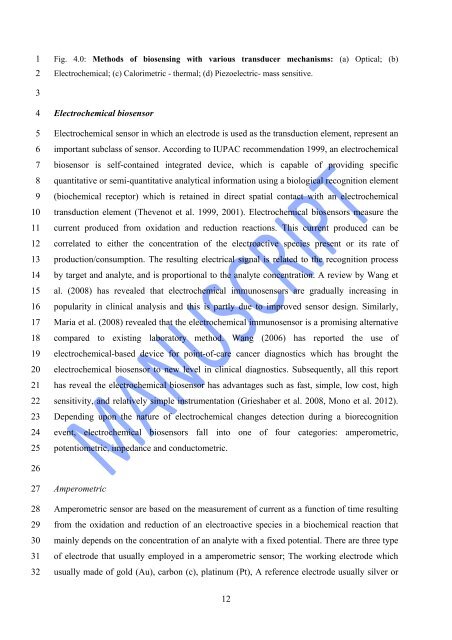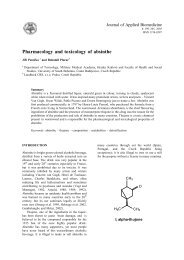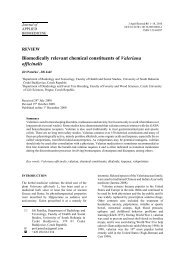Advances in biosensors: principle, architecture and applications
Advances in biosensors: principle, architecture and applications
Advances in biosensors: principle, architecture and applications
Create successful ePaper yourself
Turn your PDF publications into a flip-book with our unique Google optimized e-Paper software.
1<br />
2<br />
3<br />
4<br />
5<br />
6<br />
7<br />
8<br />
9<br />
10<br />
11<br />
12<br />
13<br />
14<br />
15<br />
16<br />
17<br />
18<br />
19<br />
20<br />
21<br />
22<br />
23<br />
24<br />
25<br />
26<br />
27<br />
28<br />
29<br />
30<br />
31<br />
32<br />
Fig. 4.0: Methods of biosens<strong>in</strong>g with various transducer mechanisms: (a) Optical; (b)<br />
Electrochemical; (c) Calorimetric - thermal; (d) Piezoelectric- mass sensitive.<br />
Electrochemical biosensor<br />
Electrochemical sensor <strong>in</strong> which an electrode is used as the transduction element, represent an<br />
important subclass of sensor. Accord<strong>in</strong>g to IUPAC recommendation 1999, an electrochemical<br />
biosensor is self-conta<strong>in</strong>ed <strong>in</strong>tegrated device, which is capable of provid<strong>in</strong>g specific<br />
quantitative or semi-quantitative analytical <strong>in</strong>formation us<strong>in</strong>g a biological recognition element<br />
(biochemical receptor) which is reta<strong>in</strong>ed <strong>in</strong> direct spatial contact with an electrochemical<br />
transduction element (Thevenot et al. 1999, 2001). Electrochemical <strong>biosensors</strong> measure the<br />
current produced from oxidation <strong>and</strong> reduction reactions. This current produced can be<br />
correlated to either the concentration of the electroactive species present or its rate of<br />
production/consumption. The result<strong>in</strong>g electrical signal is related to the recognition process<br />
by target <strong>and</strong> analyte, <strong>and</strong> is proportional to the analyte concentration. A review by Wang et<br />
al. (2008) has revealed that electrochemical immunosensors are gradually <strong>in</strong>creas<strong>in</strong>g <strong>in</strong><br />
popularity <strong>in</strong> cl<strong>in</strong>ical analysis <strong>and</strong> this is partly due to improved sensor design. Similarly,<br />
Maria et al. (2008) revealed that the electrochemical immunosensor is a promis<strong>in</strong>g alternative<br />
compared to exist<strong>in</strong>g laboratory method. Wang (2006) has reported the use of<br />
electrochemical-based device for po<strong>in</strong>t-of-care cancer diagnostics which has brought the<br />
electrochemical biosensor to new level <strong>in</strong> cl<strong>in</strong>ical diagnostics. Subsequently, all this report<br />
has reveal the electrochemical biosensor has advantages such as fast, simple, low cost, high<br />
sensitivity, <strong>and</strong> relatively simple <strong>in</strong>strumentation (Grieshaber et al. 2008, Mono et al. 2012).<br />
Depend<strong>in</strong>g upon the nature of electrochemical changes detection dur<strong>in</strong>g a biorecognition<br />
event, electrochemical <strong>biosensors</strong> fall <strong>in</strong>to one of four categories: amperometric,<br />
potentiometric, impedance <strong>and</strong> conductometric.<br />
Amperometric<br />
Amperometric sensor are based on the measurement of current as a function of time result<strong>in</strong>g<br />
from the oxidation <strong>and</strong> reduction of an electroactive species <strong>in</strong> a biochemical reaction that<br />
ma<strong>in</strong>ly depends on the concentration of an analyte with a fixed potential. There are three type<br />
of electrode that usually employed <strong>in</strong> a amperometric sensor; The work<strong>in</strong>g electrode which<br />
usually made of gold (Au), carbon (c), plat<strong>in</strong>um (Pt), A reference electrode usually silver or<br />
12





